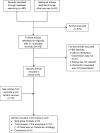Influenza in workplaces: transmission, workers' adherence to sick leave advice and European sick leave recommendations
- PMID: 27060594
- PMCID: PMC4884332
- DOI: 10.1093/eurpub/ckw031
Influenza in workplaces: transmission, workers' adherence to sick leave advice and European sick leave recommendations
Abstract
Background: Knowledge about influenza transmission in the workplace and whether staying home from work when experiencing influenza-like illness can reduce the spread of influenza is crucial for the design of efficient public health initiatives.
Aim: This review synthesizes current literature on sickness presenteeism and influenza transmission in the workplace and provides an overview of sick leave recommendations in Europe for influenza.
Methods: A search was performed on Medline, Embase, PsychINFO, Cinahl, Web of Science, Scopus and SweMed to identify studies related to workplace contacts, -transmission, -interventions and compliance with recommendations to take sick leave. A web-based survey on national recommendations and policies for sick leave during influenza was issued to 31 European countries.
Results: Twenty-two articles (9 surveys; 13 modelling articles) were eligible for this review. Results from social mixing studies suggest that 20-25% of weekly contacts are made in the workplace, while modelling studies suggest that on average 16% (range 9-33%) of influenza transmission occurs in the workplace. The effectiveness of interventions to reduce workplace presenteeism is largely unknown. Finally, estimates from studies reporting expected compliance with sick leave recommendations ranged from 71 to 95%. Overall, 18 countries participated in the survey of which nine (50%) had issued recommendations encouraging sick employees to stay at home during the 2009 A(H1N1) pandemic, while only one country had official recommendations for seasonal influenza.
Conclusions: During the 2009 A(H1N1) pandemic, many European countries recommended ill employees to take sick leave. Further research is warranted to quantify the effect of reduced presenteeism during influenza illness.
© The Author 2016. Published by Oxford University Press on behalf of the European Public Health Association.
Figures
Similar articles
-
Policies to reduce influenza in the workplace: impact assessments using an agent-based model.Am J Public Health. 2013 Aug;103(8):1406-11. doi: 10.2105/AJPH.2013.301269. Epub 2013 Jun 13. Am J Public Health. 2013. PMID: 23763426 Free PMC article.
-
Paid sick days and stay-at-home behavior for influenza.PLoS One. 2017 Feb 2;12(2):e0170698. doi: 10.1371/journal.pone.0170698. eCollection 2017. PLoS One. 2017. PMID: 28151940 Free PMC article.
-
Paid Leave and Access to Telework as Work Attendance Determinants during Acute Respiratory Illness, United States, 2017-2018.Emerg Infect Dis. 2020 Jan;26(1):26-33. doi: 10.3201/eid2601.190743. Emerg Infect Dis. 2020. PMID: 31855145 Free PMC article.
-
Health and well-being in small and medium-sized enterprises (SMEs). What public health support do SMEs really need?Perspect Public Health. 2015 Jan;135(1):49-55. doi: 10.1177/1757913914521157. Epub 2014 Feb 17. Perspect Public Health. 2015. PMID: 24535003 Review.
-
Economic evaluations of interventions against influenza at workplaces: systematic review.Occup Med (Lond). 2022 Feb 22;72(2):70-80. doi: 10.1093/occmed/kqab163. Occup Med (Lond). 2022. PMID: 34931675
Cited by
-
Feeling Positive About Reopening? New Normal Scenarios From COVID-19 US Reopen Sentiment Analytics.IEEE Access. 2020 Aug 3;8:142173-142190. doi: 10.1109/ACCESS.2020.3013933. eCollection 2020. IEEE Access. 2020. PMID: 34786280 Free PMC article.
-
TRACE-Omicron: Policy Counterfactuals to Inform Mitigation of COVID-19 Spread in the United States.Adv Theory Simul. 2023 Jul;6(7):2300147. doi: 10.1002/adts.202300147. Epub 2023 Apr 28. Adv Theory Simul. 2023. PMID: 38283383 Free PMC article.
-
Reported variability in healthcare facility policies regarding healthcare personnel working while experiencing influenza-like illnesses: An emerging infections network survey.Infect Control Hosp Epidemiol. 2020 Jan;41(1):80-85. doi: 10.1017/ice.2019.305. Epub 2019 Nov 14. Infect Control Hosp Epidemiol. 2020. PMID: 31722757 Free PMC article.
-
Absenteeism and Productivity Loss Due to Influenza or Influenza-like Illness in Adults in Europe and North America.Diseases. 2024 Dec 17;12(12):331. doi: 10.3390/diseases12120331. Diseases. 2024. PMID: 39727661 Free PMC article. Review.
-
Model for Mitigation of Workplace Transmission of COVID-19 Through Population-Based Testing and Surveillance.Popul Health Manag. 2021 Feb;24(S1):S16-S25. doi: 10.1089/pop.2020.0322. Epub 2021 Jan 25. Popul Health Manag. 2021. PMID: 33493409 Free PMC article. Review.
References
-
- Szucs T. The socio-economic burden of influenza. J Antimicrob Chemother 1999;44:11–5. - PubMed
-
- Peasah SK, Azziz-Baumgartner E, Breese J, et al. Influenza cost and cost-effectiveness studies globally—a review. Vaccine 2013;31:5339–48. - PubMed
-
- Szucs T, Nichol K. Economic and social impact of epidemic and pandemic influenza. Vaccine 2006;24:6776–8. - PubMed
-
- Keech M, Scott A, Ryan P. The impact of influenza and influenza-like illness on productivity and healthcare resource utilization in a working population. Occup Med 1998;48:85–90. - PubMed
-
- Centers for Disease Control and Prevention (CDC). CDC Recommendations for the Amount of Time Persons with Influenza-Like Illness Should be Away from Others. 2009. http://www.cdc.gov/h1n1flu/guidance/exclusion.htm. [accessed: 06.01.2016].
Publication types
MeSH terms
LinkOut - more resources
Full Text Sources
Other Literature Sources
Medical


